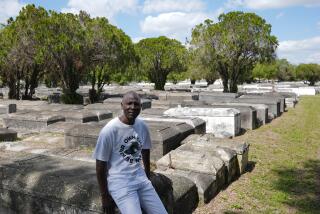Slaves of N.Y.--Faint Voices of the Dead
- Share via
NEW YORK — In life, they could be horsewhipped 40 times by civil authorities if three or more of them were seen talking on a public street. In death, they were buried in stacks as much as five deep in soil too poor to serve any other purpose.
Now, after two centuries and more of oblivion, New York’s slaves have reappeared in the city that long ago forgot them. An archeological excavation in the heart of downtown Manhattan has rediscovered the cemetery where the 18th-Century seaport disposed of its human chattel.
Scientists have excavated graves of more than 60 people, most of them believed to have been slaves, and expect to find more than 100 by the time the project is finished.
“These people, about whom nothing was recorded in their lives, have become tremendously valuable resources,” archeologist Michael Parrington said. “No one thought they were important when they lived. No one thought to write down anything about them. Now the remains of these people are telling their story.”
Between the razing of old buildings and the rising of a 34-story federal office building, progress has paused a moment to listen for the faint voices of the dead.
About 50 yards east of Broadway, scholars pinpointed the Revolutionary War-era slave cemetery. It is perhaps a brisk, 15-minute stroll from the scene of the old slave market at the end of Wall Street, and scarcely a stone’s throw from the City Hall offices of David N. Dinkins, New York’s first black mayor.
When the federal government cleared the property to build an office tower, historical preservation laws required an archeological survey. Using maps, deeds and building plans, archeologists concluded that, although previous construction had ruined most of the graves, a few should have been preserved under an intersection of alleys from the 19th Century.
“Once we began digging, we found even more than we expected,” Parrington said.
It is painstaking work, conducted with dentist’s tools and fine-haired brushes. Excavating and removing a single skeleton can take more than a week. Such care and attention could delay construction on one of the most expensive civilian building projects in federal government history.
“If we reach that point, delays for the archeology could cost up to $1 million per day,” said William Diamond, regional administrator for the General Services Administration. “But we’ve uncovered 18th-Century New York here. The full history of this site will be given top priority.”
Scientists are digging 12 hours a day, seven days a week, trying to keep the project on schedule. They will not know what they have found until they move from the field to the lab, Parrington said.
Some preliminary conclusions can be drawn, however.
Life in slavery, a New York institution from the arrival of the Dutch in the early 1600s to abolition in 1824, was hard and bitter. Half of the graves held infants and children. When death came, there was no money for memorials.
Most corpses were wrapped in cloth for burial. Rusted shroud pins are have been found. A few graves have been found with military buttons among the bones. Parrington said these may have been black soldiers in the Revolutionary cause, buried by the British when they died as prisoners of war.
Around the site, scientists have found signs of old tanneries and pottery works; the slaves were buried amid the foul, heavy industry of the day. But the ground where the graves were dug was not even fit for mining clay and, in its day, was the least desirable land in Manhattan.
“It is an irony,” Parrington said, “that this real estate, once so poor (that) its only value was to bury poor black people, is now so expensive.”
Parrington’s specialty is excavation of black urban burial grounds.
In 1984, exploring a cemetery in Philadelphia, Parrington found evidence of ancient burial customs. On some coffins was a single shoe, symbolizing the journey into the next life. Plates balanced on the chests of several skeletons signified the deceased’s last meal. Coins lay in several graves, to pay the ferryman for the crossing to the next world.
But Philadelphia’s blacks were free men and women. In Manhattan, where most of the dead were slaves, Parrington has found no trace of tradition, just of simple burials.
More to Read
Sign up for Essential California
The most important California stories and recommendations in your inbox every morning.
You may occasionally receive promotional content from the Los Angeles Times.













